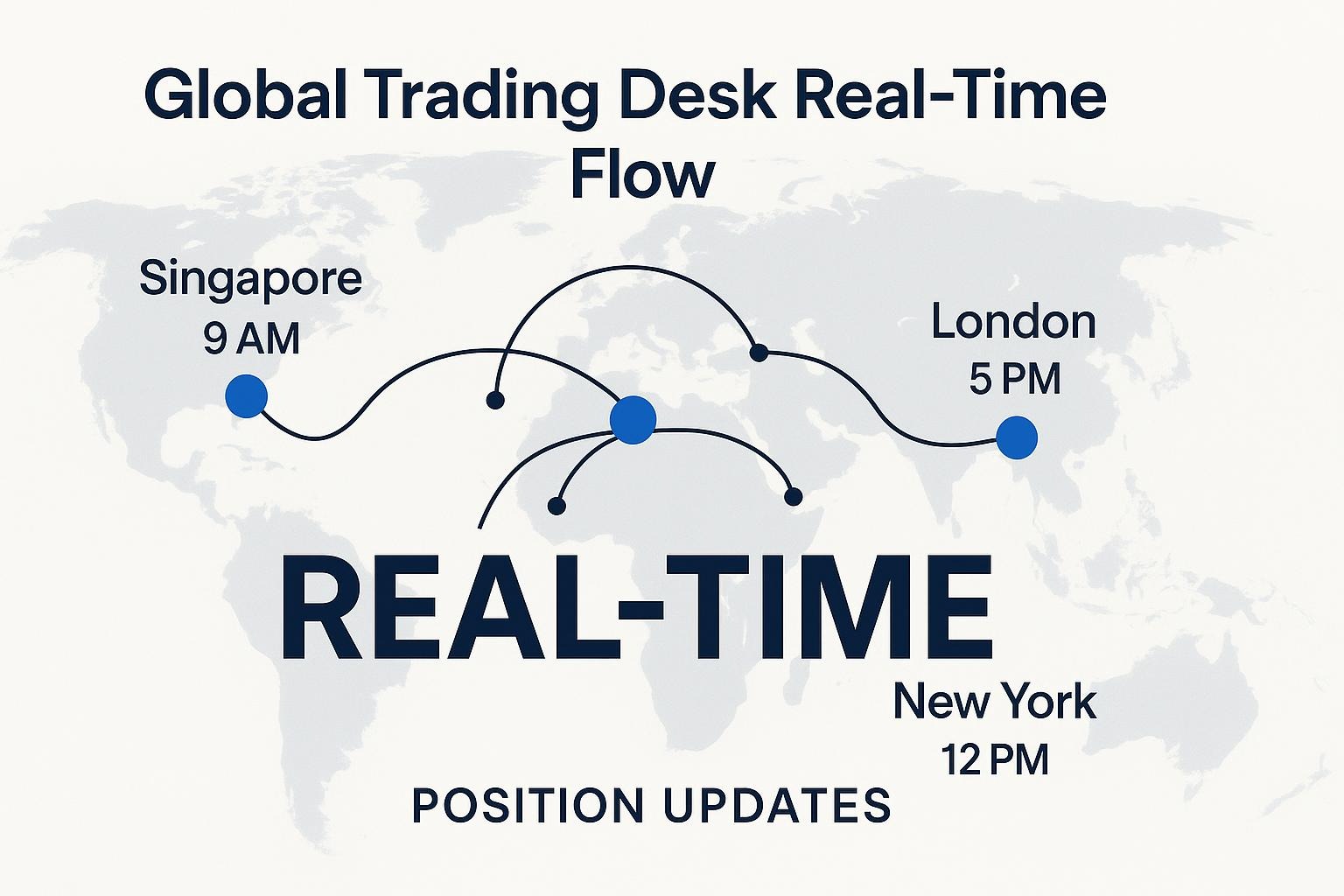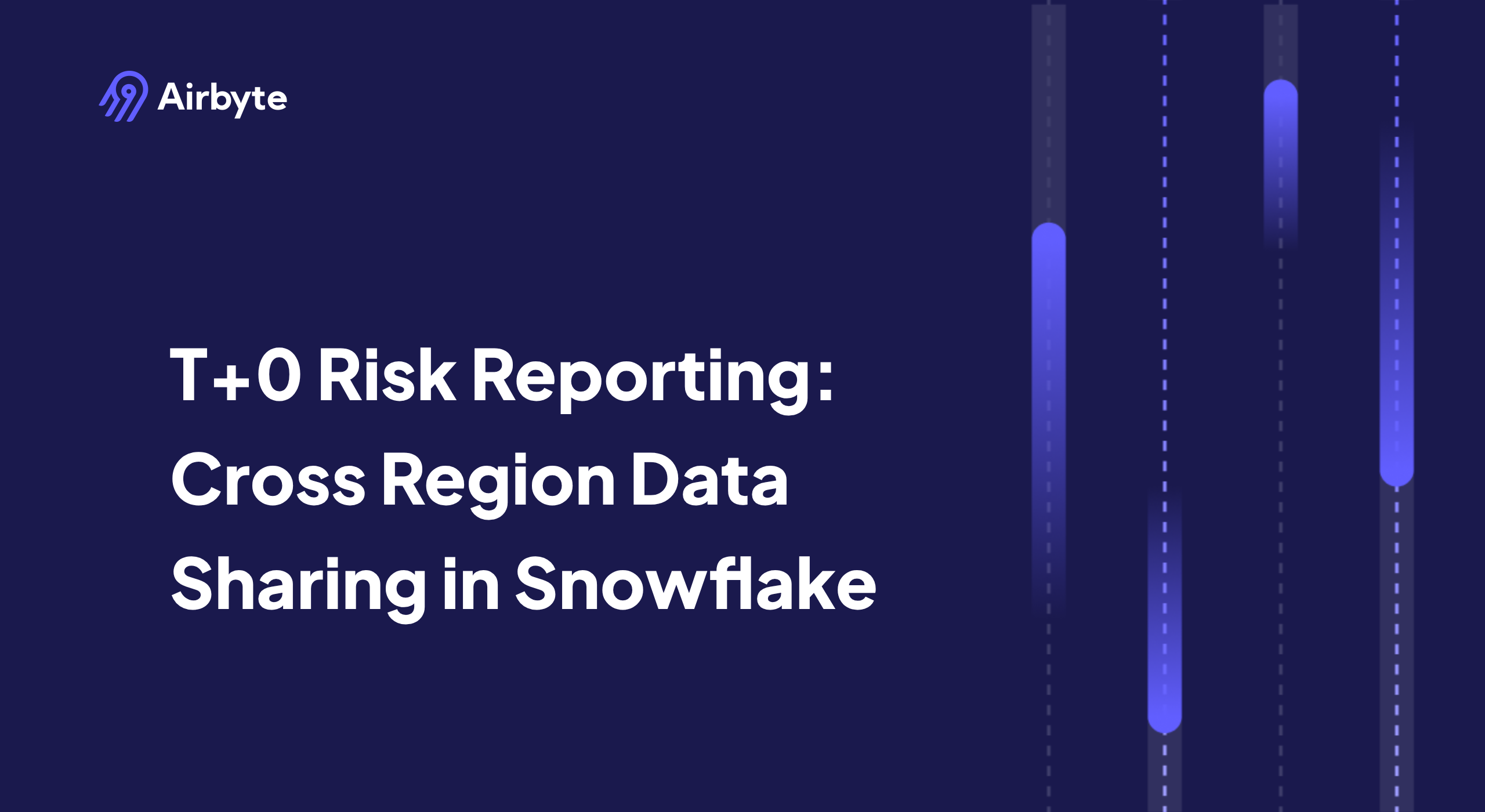T+0 Risk Reporting: Cross-Region Data Sharing in Snowflake
Summarize this article with:
✨ AI Generated Summary
Snowflake cross-region data sharing enables near-real-time risk reporting by sharing metadata pointers instead of copying data, allowing global teams to query live trade positions without replication delays or storage overhead. This approach ensures compliance with data sovereignty laws through secure, governed access controls, row-level security, and encrypted audit trails, while eliminating reconciliation issues inherent in traditional ETL pipelines.
- Shares live data across regions and clouds with minimal latency and no physical data movement.
- Supports regulatory compliance (GDPR, DORA, MAS, etc.) by keeping data in home regions and enforcing strict access controls.
- Enables unified, real-time risk visibility for global trading desks, reducing operational risks and improving decision-making speed.
- Integrates with tools like Airbyte for real-time ingestion while respecting data residency requirements.
Financial markets never sleep, yet most risk-reporting systems do. When London closes positions at 5 PM GMT and Singapore opens at 9 AM, traditional overnight ETL pipelines create dangerous blind spots in exposure visibility. Risk teams wait hours for position reconciliation while traders across three continents generate new exposures every minute. Your New York risk engine ends up querying yesterday's Singapore positions instead of live data, leaving you exposed to concentration breaches and regulatory violations.
Snowflake cross-region data sharing eliminates bulk data copying. Instead of moving terabytes of trade data, you share live table references through metadata pointers. New York's risk calculations can query Singapore's trade blotter directly with minimal data movement and very low latency, delivering nearly real-time unified exposure visibility across all trading desks.
What Is Snowflake Cross-Region Data Sharing and How Does It Work?
Cross-region data sharing provides direct access to data across geographical regions without physically moving or copying it. When you publish a share, Snowflake transfers only metadata pointers (never the raw data) to the target region, keeping source tables in their original location while making them queryable from any compliant Snowflake account.
On the provider side, you expose specific tables or secure views. On the consumer side, those objects appear local, yet every SELECT executes against the original storage location. Snowflake's metadata-based architecture enables near-real-time data sharing between regions, significantly reducing ETL lag and making inserts or updates in Singapore rapidly visible in Frankfurt under many conditions.
Traditional replication copies entire datasets, requiring sync schedule management, additional storage, and version reconciliation. Cross-region sharing eliminates these operational burdens, delivering a single source of truth while reducing redundant storage costs and using the platform's existing centralized governance.
Why Is Cross-Region Architecture Critical for Real-Time Risk Reporting?
Regulators are aggressively shrinking the window between trade execution and disclosure. ESMA's push for shorter settlement cycles in the EU (moving toward T+1 settlement) signals where global markets are headed, though firms are not yet required to surface exposures on the same day trades hit the books. Every trading desk needs to feed risk engines with live data to meet these evolving requirements.
The business stakes match regulatory pressure:
- Concentration limits breach within minutes during market volatility
- Stale snapshots create blind spots when Asia and New York operate on different data versions
- Early warning signs get missed before banks overrun credit, liquidity, or capital thresholds
Traditional data pipelines break under this reality:
- Batch ETL introduces hours of latency between trade execution and risk visibility
- Copy-based replication forces manual reconciliation across regional systems
- Regional data silos create conflicting versions of the same positions
- Moving full datasets across networks proves slow and expensive while failing real-time requirements
Snowflake's metadata-driven sharing transforms this approach entirely. Data remains in its home region while you query it instantly through secure pointers, avoiding physical transfers and redundant storage while maintaining a single authoritative dataset for exposure, liquidity, and portfolio analytics.
How Can You Architect Secure Cross-Region Data Sharing in Snowflake?
Building a secure cross-region architecture requires three key components: regional account structure, governance controls, and performance optimization.
Regional Accounts and Shares
Anchor each regulatory jurisdiction in its own dedicated Snowflake account to respect local compliance requirements while exposing data globally through secure shares rather than physical copies. Grant a provider role in the source account, create a share that references required tables or views, then replicate that share to the target region using Snowflake's cross-region capabilities (all driven by metadata, not data movement).
Since the share functions as a pointer, updates appear everywhere instantly, eliminating the reconciliation headaches that plague ETL pipelines while cutting storage costs significantly.
Governance and Security
Governance lives in your role design strategy. Assign access at the least-privilege level and layer on column-level masking for sensitive fields. The policies travel with the share, so consumers inherit the same protections automatically. End-to-end TLS encrypts every hop, and Snowflake's audit history records each query, providing the evidence trail regulators expect. Network policies and authorized IP lists further restrict entry points, tightening the blast radius of potential breaches.
Performance Optimization
For optimal performance, build secure views that enforce row filters close to the source, and size warehouses in the consumer region based on local demand. The result is consistent, low-latency queries without over-replication concerns.
A Singapore trading platform publishes positions via a secure share, replicated to London, and consumed there under MAS and DORA constraints. Teams see the same live data, governed by one set of controls, without moving unnecessary bytes across regions.
What Compliance and Data Sovereignty Challenges Should You Plan For?
Global risk reporting creates an inherent tension. You need worldwide visibility to calculate T+0 exposures, yet every jurisdiction zealously guards its data. Regulations like GDPR, DORA, MAS, APPI, and CCPA restrict where customer or trading records can reside, creating the biggest compliance hurdle for cross-border reporting.
Consider a bank that keeps EU trade data in Frankfurt but shares masked position views with its New York risk desk. Because the data never leaves the EU region and U.S. consumers see only what their roles permit, the setup satisfies both GDPR and SEC record-keeping rules while delivering same-day risk figures.
How Can You Build a Cross-Region Risk Reporting Workflow in Snowflake?
Establishing an effective cross-region risk reporting workflow requires methodical planning focused on real-time data accessibility and compliance. Here's how to implement this process successfully:
1. Establish Your Foundation
Begin by identifying critical data domains for risk assessment, including positions, trades, counterparties, and market data. Establish primary Snowflake accounts in each region where compliance demands local presence, ensuring your data strategy aligns with regulatory requirements.
2. Configure Data Sharing
Create secure database shares to expose relevant tables and views, then configure reader accounts in each consuming region. This setup enables team members to access shared data seamlessly and in real time while maintaining security boundaries.
3. Implement Security Controls
Implement row-level security and column-level masking to meet regulatory standards. These measures control access to sensitive information, protecting privacy and ensuring legal compliance across jurisdictions.
4. Enable Real-Time Data Flow
Set up near real-time data ingestion from source systems, providing timely information essential for risk evaluations. Create centralized views that aggregate cross-region data on positions and exposures for unified reporting.
5. Monitor and Maintain
Establish automated monitoring tools to track data freshness and replication status, ensuring information remains current and reliable for continuous risk assessment.
When configuring technical details, focus on setting up shares with strict permissions and security measures. Create secure views to enforce data access policies, ensuring only authorized personnel can view specific data elements. Use Snowflake Streams and Tasks for incremental processing to maintain a smooth data flow across your network.
For external system integration, connect data from trading platforms into Snowflake. Implement change data capture (CDC) patterns to capture near-real-time data while maintaining detailed data lineage and provenance for audit purposes.

What Does Real-Time Risk Management Look Like in Practice?
Open your risk dashboard in New York and instantly see positions traders just booked in London. The query crosses the ocean, not the data. Exposures refresh immediately without replication lag or reconciliation delays.
Your Singapore desk executes a substantial FX trade at 3 AM local time. Within seconds, your New York risk team sees updated VaR calculations and position limits across all global books. No overnight batch jobs, no reconciliation between regional systems, just one version of truth flowing through secure metadata references.
This approach delivers faster analytics, eliminates reconciliation headaches, and provides audit trails that regulators accept (all from a single governed dataset). The transformation is profound: from waiting hours for overnight batch processing to seeing global exposures update in real time, empowering risk managers to act on complete, current information rather than yesterday's snapshots.
How Can You Build T+0 Risk Reporting With Airbyte and Snowflake?
Connecting trading platforms and market data feeds to Snowflake requires reliable, real-time ingestion that keeps pace with global markets. Airbyte's 600+ connectors handle data movement from source systems to Snowflake while cross-region sharing provides the global visibility your risk teams demand.
With Airbyte Enterprise Flex, you deploy data planes in each regulatory region to meet sovereignty requirements while maintaining centralized control through a cloud-hosted control plane. Your sensitive trading data never leaves its home jurisdiction, yet you get the same Airbyte connectors and quality everywhere. Talk to sales to discuss your cross-region risk reporting requirements.
Frequently Asked Questions
Does Snowflake cross-region data sharing replicate the actual data?
No. Snowflake transfers only metadata pointers to the target region. The actual data remains in its original storage location, and queries execute against the source region. This approach eliminates the storage costs and synchronization overhead of traditional replication while providing near real-time access to shared data.
What latency should I expect when querying cross-region shares?
Query latency depends on network distance between regions and query complexity. Most cross-region queries complete within seconds under normal conditions. For T+0 risk reporting, position updates typically appear in consumer regions within seconds of being written to the source region, though this can vary based on network conditions and data volume.
How does cross-region sharing work with data sovereignty regulations?
Snowflake's metadata-only sharing model helps satisfy many data residency requirements because the actual data never leaves its home region. You can apply row-level security and column masking at the source to control what consumers see, ensuring sensitive data stays protected. However, you should consult with legal counsel to verify compliance with specific regulations like GDPR, CCPA, or industry-specific requirements.
Can I share data between different cloud providers using Snowflake?
Yes. Snowflake supports cross-cloud data sharing between AWS, Azure, and Google Cloud Platform. The same metadata-based sharing mechanism works across cloud providers, allowing you to share data from AWS to Azure or any other supported combination. This capability is particularly valuable for organizations with multi-cloud strategies or when integrating with partners using different cloud platforms.

.webp)
